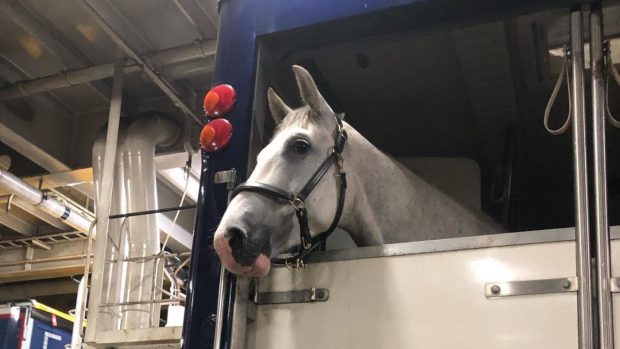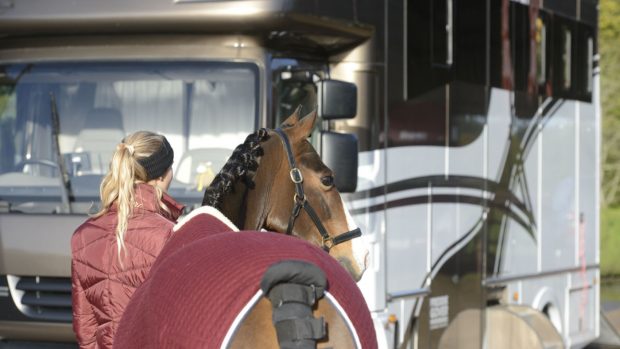Like people, horses are travelling more and more. This may involve trundling down the road in a trailer to their local show or being whizzed further afield in a sophisticated lorry, not to mention the increasing number that are now flown all over the world.
As far as a horse is concerned, it makes little difference whether they are being transported in a vehicle with wings by air or one with wheels on a road, or for that matter within a box on a boat. What matters is that the journey is smooth and there are no long delays.
A lot of effort and research has gone into providing guidelines for safe equine transport. Particular credit is due to Dr Des Leadon FRCVS of The Irish Equine Centre, who has given many useful recommendations.
Before the journey
Planning is crucial, whatever the journey. A recent nightmare road accident in the States involved more than 20 horses in one giant transporter. The advice of the vet who dealt with the scenario was that you always to be prepared for the worst. This should include the obvious, such as taking enough lead ropes, tack and rugs for all horses and sufficient food and water with you. If you are going any distance, make sure supplies are available at all rest stops and that there will be the opportunity for feeding and water at least every 6-8hr.
Know your route. Ensure you have all the documentation you could possibly need, including passports, insurance papers and contact details for vets. Before loading, check that the vehicle is safe, especially the floor. Any vet who has seen the injuries that occur when a horse’s leg goes through the floor welcomes every possible precaution to avoid such accidents.
Training makes sense, so that the horse is familiar with the experience and less likely to be afraid. This can include making sure horses feel comfortable wearing travel boots and are safe to load and unload. When horses are difficult to load, the whole enterprise becomes more stressful, so it is best resolved in advance. Many professional transporters use a bridle or Chiffney bit to help control the horse while loading and unloading.
Water and electrolytes: it is important to prevent dehydration and reduce the risk of impaction colic by encouraging your horse to drink. Some people camouflage the taste of strange water with additives, such as apple juice. Give this in advance, so that the horse will not notice any change. Others give electrolytes or water by stomach tube before travelling. It is, however, important not to put the horse off drinking of its own accord and is best to offer water frequently rather than force it on a horse.
Body weight: horses tend to lose weight on long journeys, so this should be monitored. It is thought that some of the most successful international equine competition horses cope without losing weight because they are calm and accustomed to travel.
General health: this is well summarised by Des Leadon: “Sick horse on, sicker horse when getting off.” Unless it is being moved to an equine hospital for treatment, a sick horse should not be travelled at all. Horses with a fever or nasal discharge are particularly at risk of developing shipping fever. Make sure horses are properly vaccinated and that dust allergies are under control.
Medication: the best advice is that unnecessary medication should be avoided. Increasingly stringent security regulations mean that it is more problematic to carry injectable medication on to flights for horses. Plus there is the issue of dope testing if en route to a competition. Some horses are given a laxative bran mash or liquid paraffin by stomach tube before a long journey to reduce the incidence of colic. Rumours abound of colic-related equine fatalities on flights, so it is worth consulting your vet about the best possible precautions. There is less justification for non-routine treatment for shorter road trips and it may be unnecessary on flights.
During a journey
Horses must be supervised as carefully as possible while travelling. Horses travel better when it is cool, so modify ventilation, muck out where possible and avoid travelling in the heat of the day. If the travelling conditions are hot or humid and the horses sweat more, then water obviously should be offered more frequently.
One of the biggest problems for the long-distance equine traveller is the practice of tying horses up by their headcollars so that they are stuck in an unnatural head-held-high posture. Normally, they would put their head down, but while travelling they are prevented from doing so. This will affect the clearance of mucus from the airways, as well as causing bacteria to descend towards the lung. Together, this increases the risk of pneumonia and chest infection, known as shipping fever, that affects about 6% of horses if they are transported for more than 8-12hr.
After a journey
At every opportunity, horses should be allowed to put their heads down and to eat and drink. Once unloaded, they should show interest in hay and water within 2hr and if they are not interested, should have their temperature checked. It is sensible to check their weight on arrival, repeatedly check the temperature and watch carefully for signs of disease, lameness or injury.
Recent work on immunological effects of transport concluded that there are measurable differences in immunity of transported horses. Following transport stress, their immunity takes about 24hr to recover, so they may be more susceptible to infectious disease. The same work showed that cross-tied horses are more likely to suffer from dehydration and immune system dysfunction than those carried without head restraint.
Other investigations have been carried out on jet lag, which is also thought to affect horses. It appears that long journeys over several time zones can be detrimental and, not surprisingly, it is recommended that a horse has several days to recover before competing overseas.
Work has been done on long-distance equine travel, but much of what has been learnt also applies to shorter trips. Despite planning, any short trip can become long and complicated, so it is best to be prepared.
This veterinary feature was first published in Horse & Hound (17 February, ’05)




